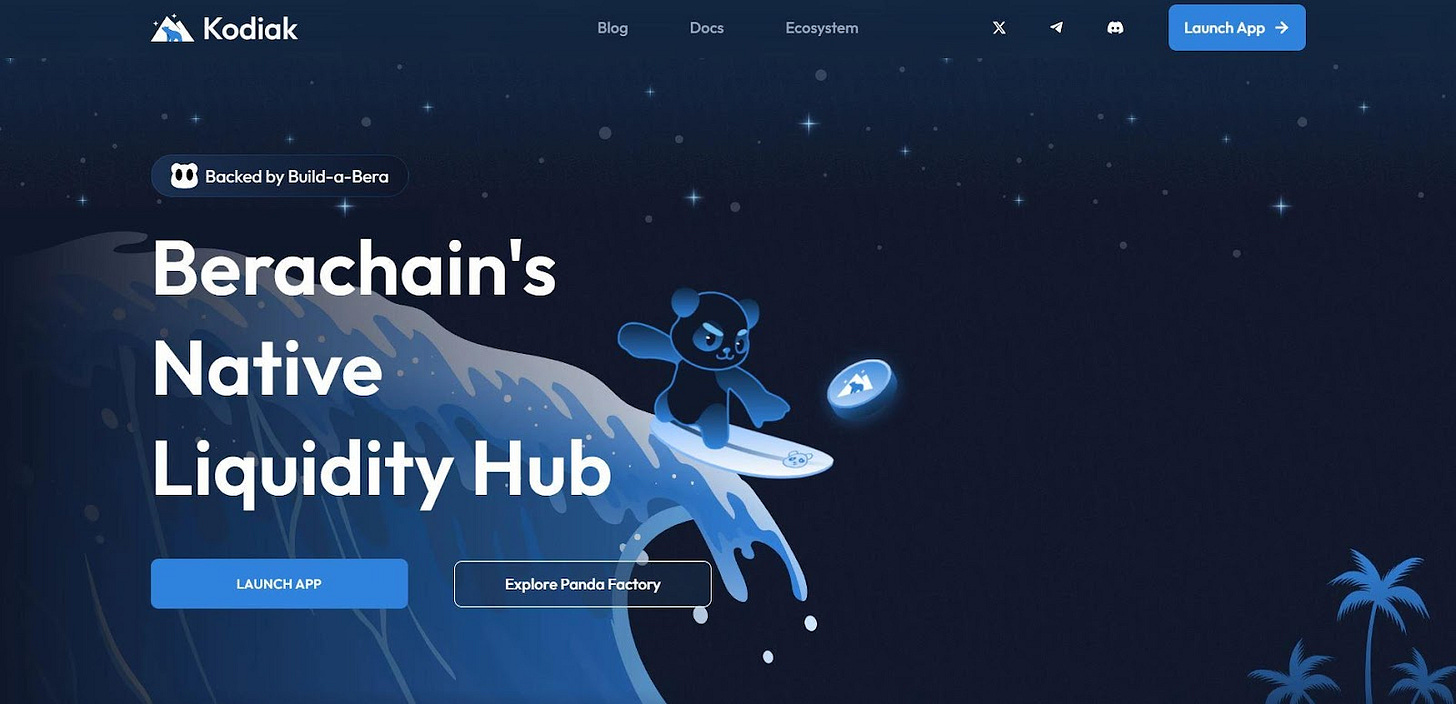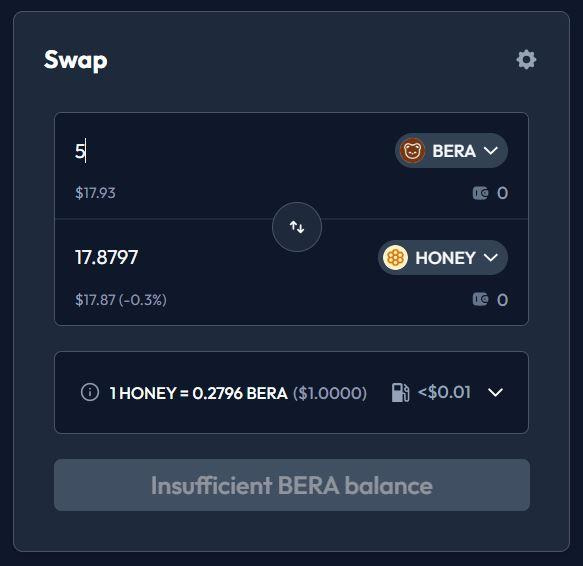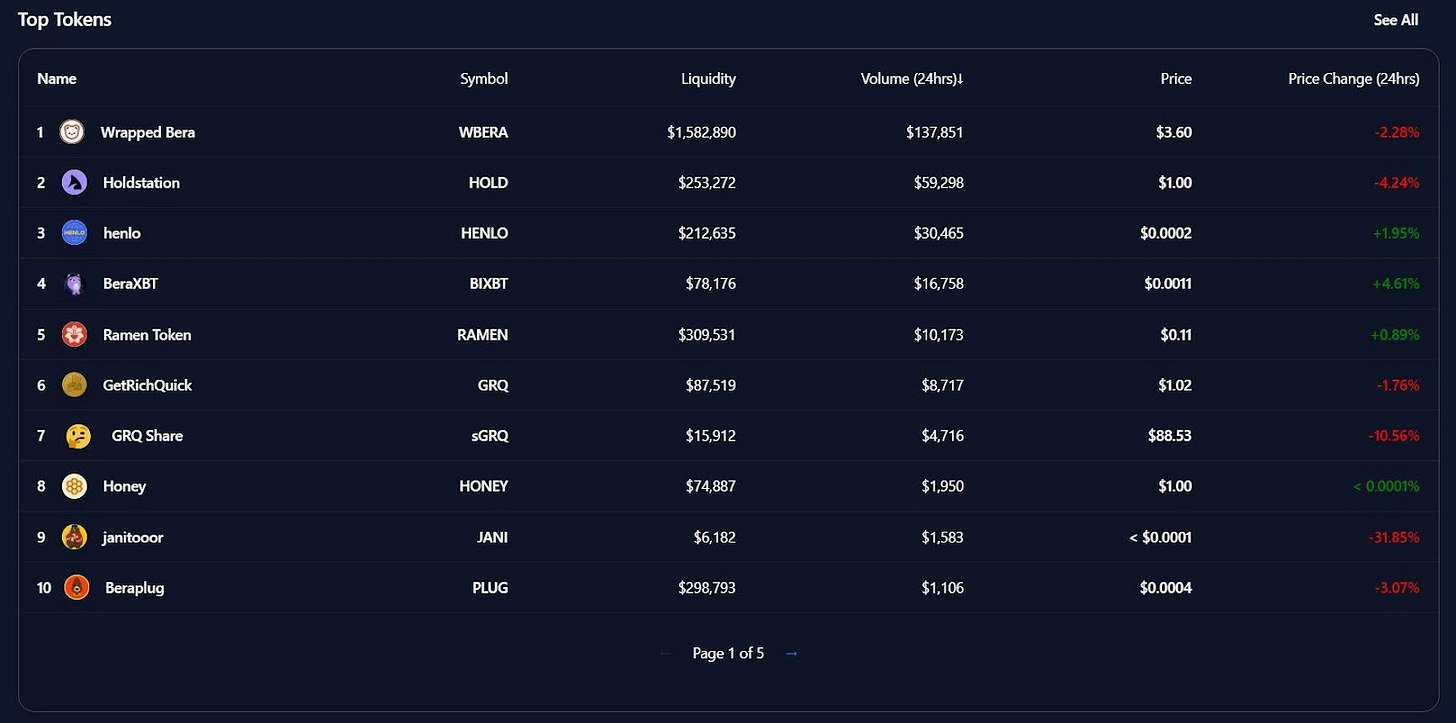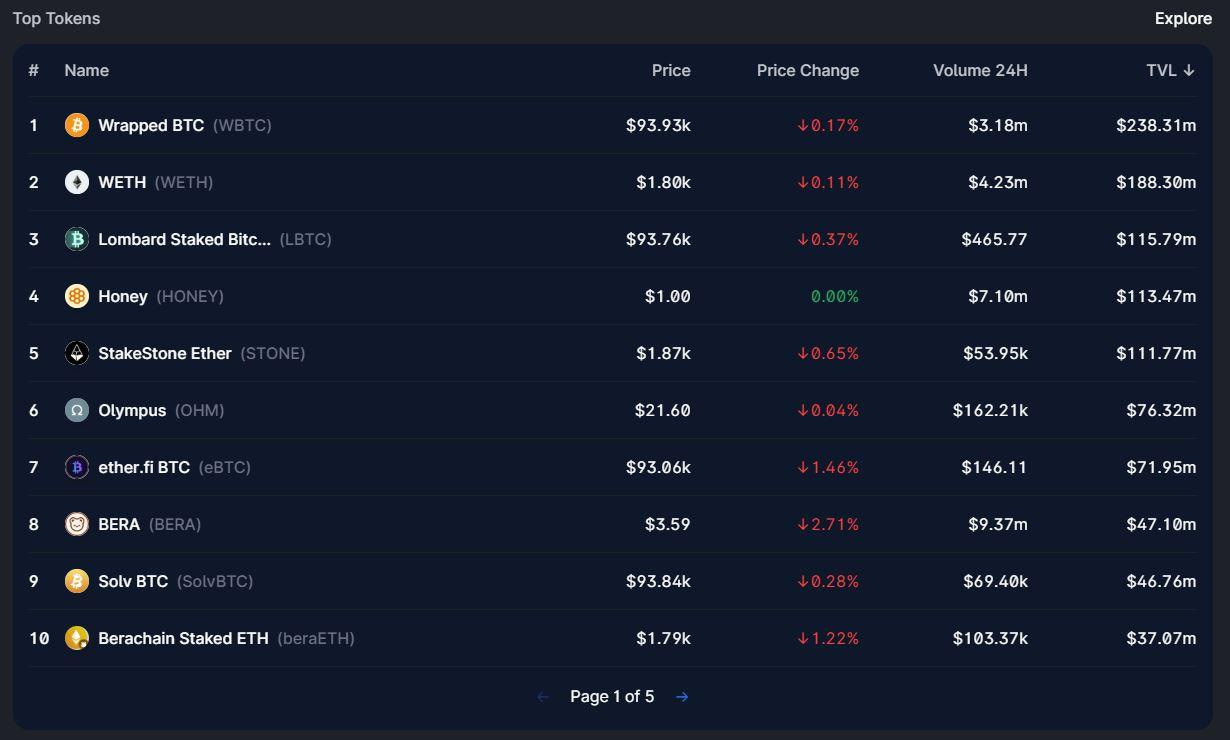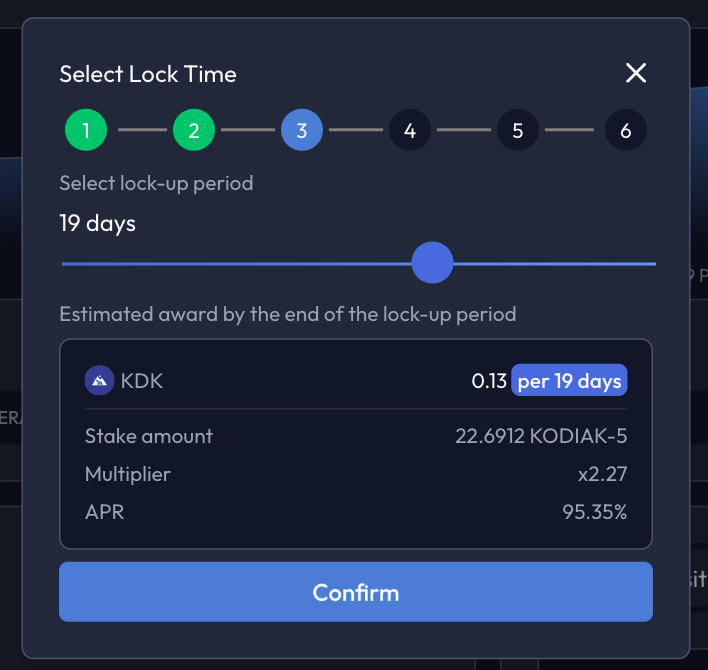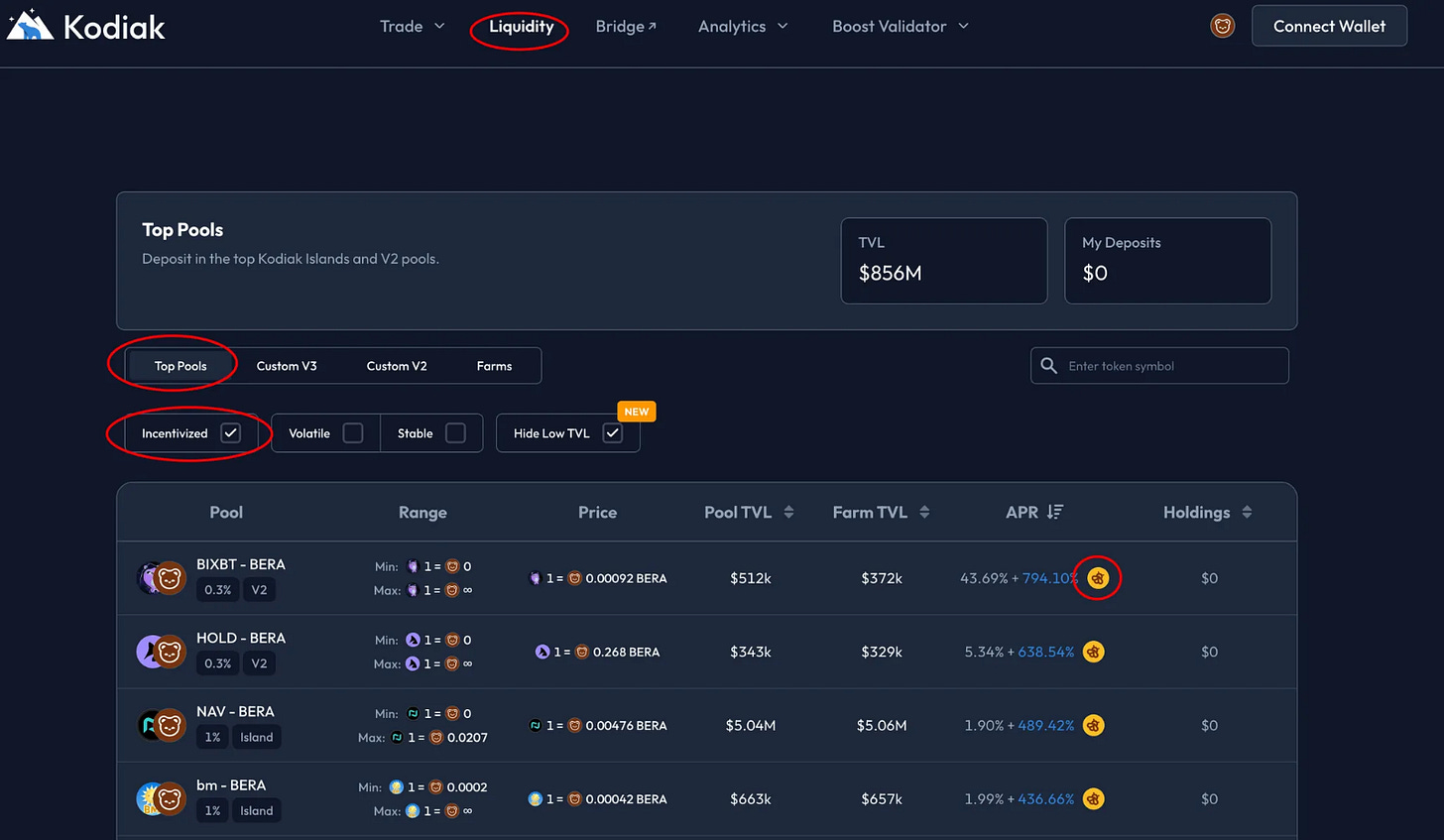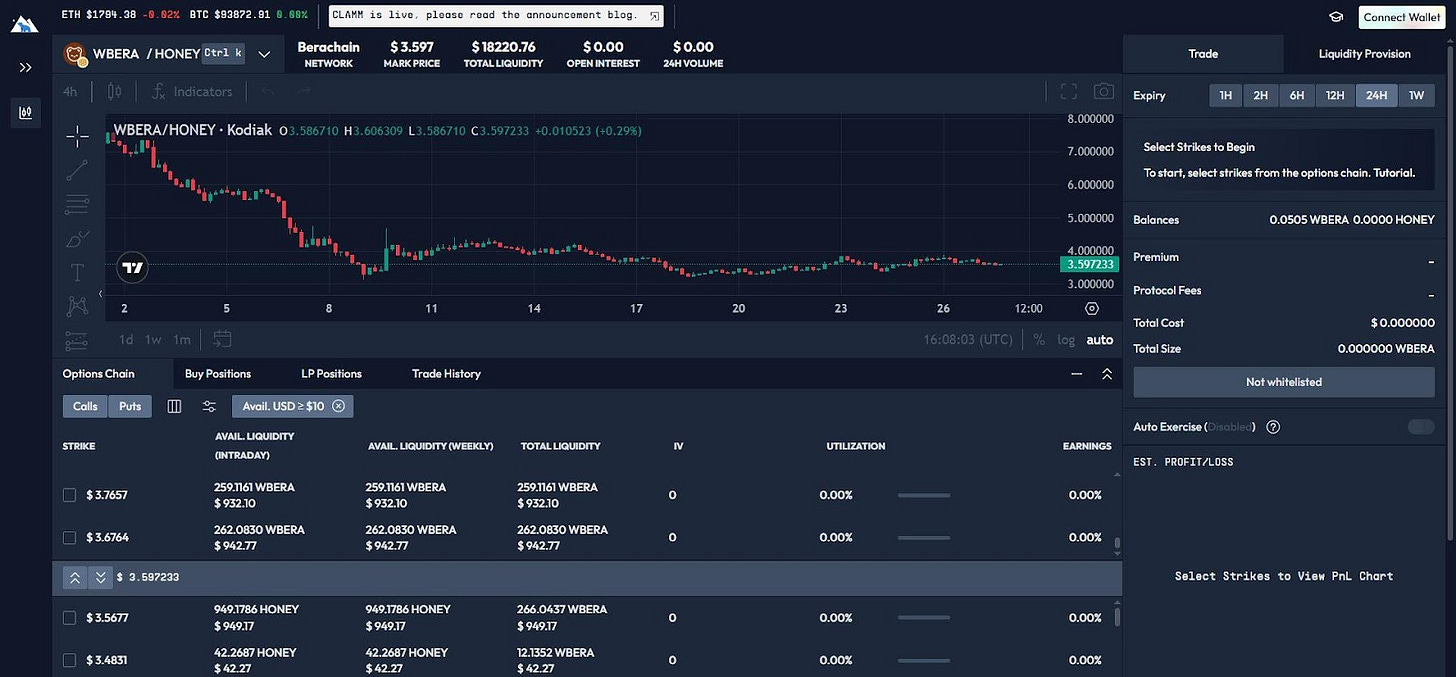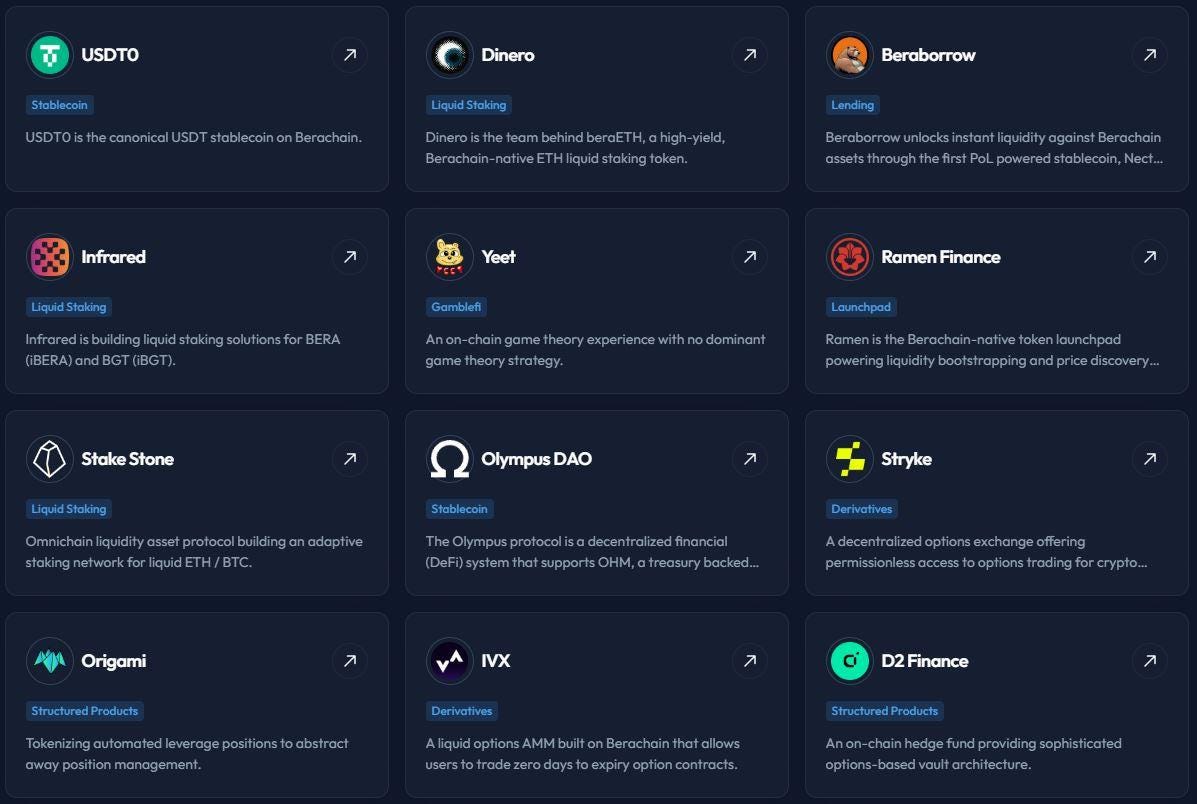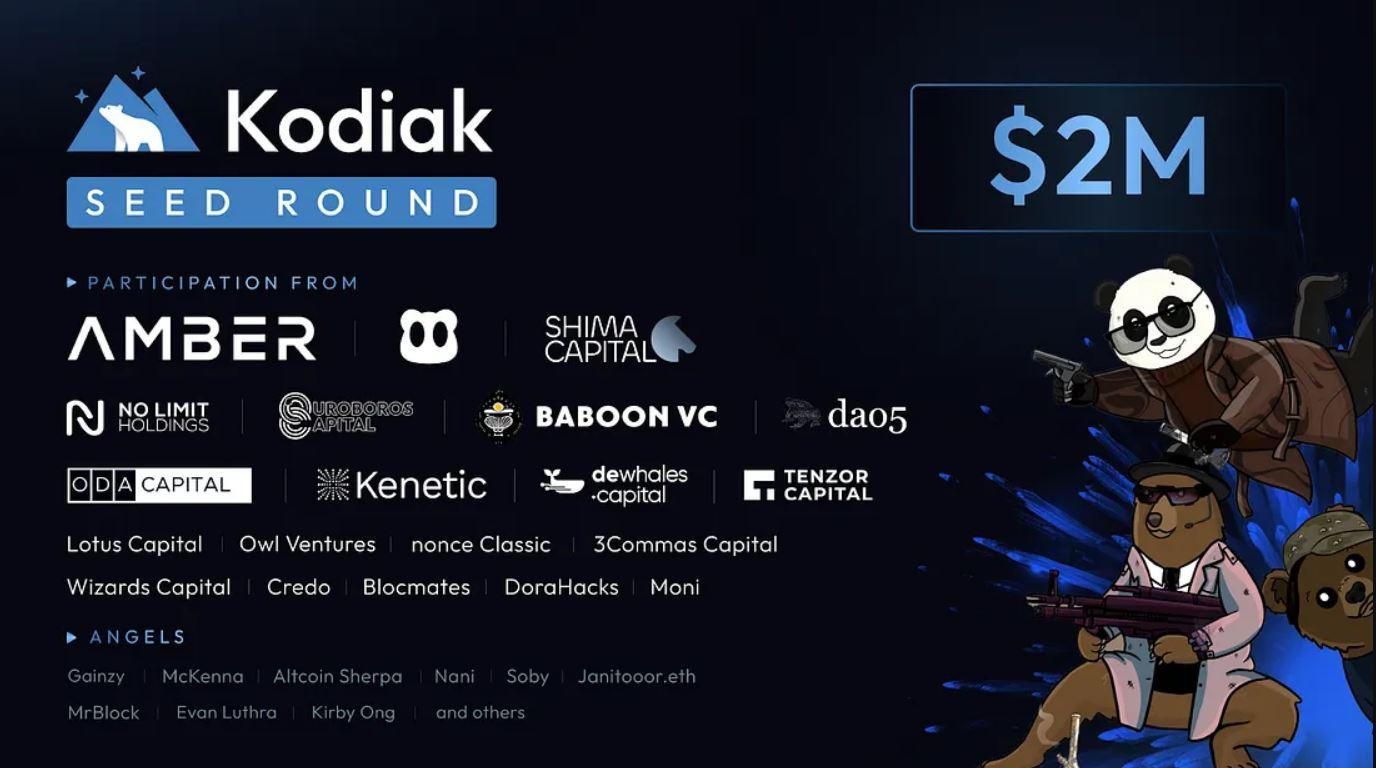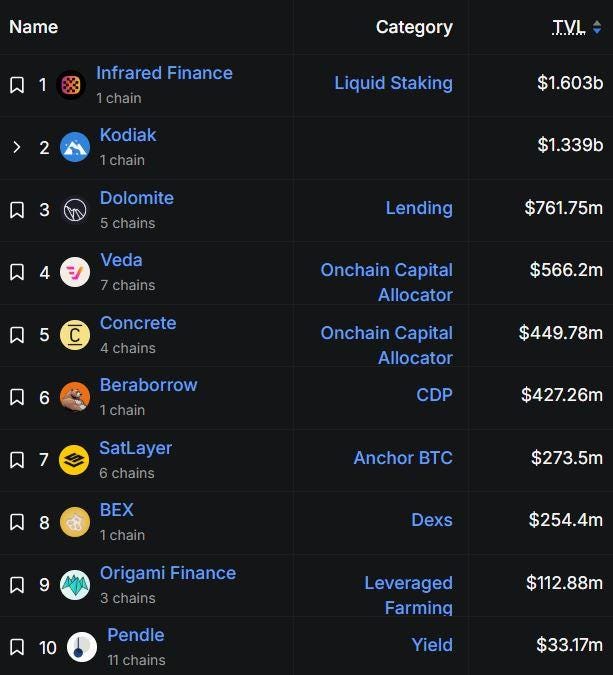Kodiak Explained: A Berachain-based DEX with Novel Liquidity Solutions
Disclaimer: The content presented in this article, along with others, is based on opinions developed by the analysts at Dewhales and does not constitute sponsored content. At Dewhales, we firmly adhere to a transparency-first philosophy, making our wallets openly available to the public through our website or DeBank, and our articles serve as vehicles for self-expression, education, and contribution to the ecosystem.
Dewhales Capital does not provide investment advisory services to the public. Any information should not be taken as investment, accounting, tax or legal advice or as a recommendation to purchase, sell or hold or to pursue any investment style or strategy. The accuracy and appropriateness of the information is not guaranteed by Dewhales Capital.
1. Overview
2. Architecture, components, and features
3. Team
4. Tokenomics
5. Partners and backers
6. Development, roadmap, and future steps
7. Potential competitors
8. Community
9. Final thoughts
10. References
1. Overview
Kodiak is a liquidity hub for Berachain, aiming to become the home for all trading on this liquidity-centered network. Kodiak offers traders unparalleled trade execution, user experience, and lowest slippage. On the other hand, protocols and LPs can enjoy more control over their liquidity, choosing their LP strategy and optimizing for fee efficiency.
In essence, Kodiak acts as liquidity DEX with automated liquidity management and sustainable incentives. Its features include:
Supporting stable and volatile assets
Automated rebalancing
Ranges are calculated statistically
Deposits are pooled together into a fungible concentrated liquidity range
2. Architecture, components, and features
Kodiak, is the first vertically-integrated liquidity hub on Berachain, offering a full suite of trading and liquidity solutions:
1. Kodiak DEX (Swap):
This is a decentralized exchange native to Berachain. The DEX is powered by its V2 (full-range) and V3 (concentrated) AMMs, both of which are based on their respective Uniswap AMM designs. However, unlike Uniswap, Kodiak has the fee switch turned on from the start. The DEX provides users with a non-custodial, highly capital-efficient trading and liquidity provision experience.
Token swaps are optimized for users by Kodiak's Pathfinder router, which automatically finds the best route across V3 and V2 liquidity pools for efficient trade execution.
This smooth process relies on the availability of ample liquidity for the desired token pair. When liquidity is sufficient, swaps are executed as single hops, resulting in lower fees and minimized slippage for users. In situations with limited liquidity between input and output tokens, Pathfinder utilizes multi-hop swaps, intelligently linking multiple pools to complete the exchange smoothly.
Trades routed through both V2 and V3 liquidity accrue fees based on the specific pools and price ranges they engage with along their path.
2. Pools:
The Kodiak DEX enables users to provide liquidity to the protocol and earn trading fees. Users have the flexibility in providing liquidity on the DEX in the following ways:
V2 (full-range) liquidity: For V2 liquidity, liquidity positions are represented as shares of the liquidity pool. When a liquidity provider contributes to a V2 liquidity pool, they receive ERC-20 LP tokens representing their proportional ownership of that specific pool. These LP tokens serve as a proof of ownership in the pool's liquidity.
V2 liquidity providers do not need to manually claim fees. Instead, fees are automatically accrued and added to the liquidity pool over time. As trades occur within the liquidity pool, a portion of the trading fees is distributed proportionally among liquidity providers based on their share of the liquidity provided. This process continuously compounds, increasing the LP's holdings in the pool, including their earned fees, all while remaining within the pool's liquidity.
V3 (concentrated) liquidity: The Kodiak V3 AMM, based on Uniswap V3, provides users with the ability to create V3 (concentrated) liquidity positions for a token pair. These positions focus liquidity on a specific price range, represented by ticks.
When users create V3 liquidity positions, they receive an ERC-721 Non-Fungible Token (NFT) as a receipt token. This NFT position contains information about the price range that the liquidity is concentrated in, the amount of each token contributed, the fee tier selected for the provided liquidity and other parameters specific to the liquidity provision. For each token pair, distinct liquidity pools exist for each of the unique fee tiers where liquidity is deployed.
The NFT position serves as a distinct receipt token, enabling LPs to effectively manage and monitor their specific liquidity contribution within the pool. For each V3 liquidity position, the LP can also choose to increase or remove (all or a portion) of their liquidity. When liquidity is removed, the LP will also automatically claim the accrued trading fees proportionate to the liquidity withdrawal amount. Accumulated fees can also be manually claimed without removing liquidity.
Islands (auto-managed) liquidity: Modified from Arrakis V1 vaults, these are automated liquidity managers with 'set-and-forget' strategies. Depositing liquidity into one of Kodiak's Islands is the most straightforward method for contributing liquidity on the Kodiak DEX. These Islands are automated liquidity management vaults with predefined rules tailored for V3 liquidity. These rules are designed to establish optimal ranges for a given Island's token pair and systematically rebalance liquidity to ensure that it consistently remains in-range.
When liquidity is added to an Island, the protocol responds by minting Kodiak Island shares, which are then allocated to the liquidity provider. On the other hand, the burning of Kodiak Island shares facilitates the redemption of a corresponding portion of the pool's V3 position liquidity, accompanied by the retrieval of earned fees. Essentially, holding Kodiak Island shares represents proportional ownership or shares of the underlying V3 position. In sum, key benefits of the Islands include:
Simplified liquidity provision through standard ERC20 interface
Liquidity is rebalanced to stay "in range" and balanced around "fair price" (for managed Islands)
Compatible with Berachain Proof-of-Liquidity, and eligible for $BGT whitelisting
Fungible ERC-20 representation of Concentrated Liquidity positions
Automatic fee compounding
Rebalance using liquidity through-out Berachain, not just what's in the pool
The minted Kodiak Island shares are ERC-20 tokens which can be staked into a Farm or PoL Reward Vaults to earn additional incentives for eligible Islands (Sweetened Islands) or rehypothecated throughout various Berachain DeFi applications.
The protocol provides users with two types of Kodiak Islands:
Kodiak Islands: Kodiak Islands are deployed and permissioned by Kodiak Protocol and rebalanced by permissioned parties (manager) authorized by the protocol. Each Island has a strategy designed to keep the Island "in range" around "fair price" in order to be compatible with Proof of Liquidity. For each island, the strategy involves determining the "fair price" (with an off-chain, external oracle), a range around that price (determined based on the volatility of the underlying pool), and a rebalancing frequency. Kodiak Islands charge a manager fee of 10% of LP fees generated; these are used to fund and cover all gas fees, infrastructure, R&D, and other operational costs of "running the Island."
Permissionless Islands: Deployed by anyone, this enables anyone to create ERC-20 wrappers on a particular "fixed range" Kodiak V3 pool of their choice. For trust minimization, once the Island is deployed, the ranges cannot be adjusted. Permissionless Islands can be used to ERC-20 tokenize concentrated liquidity positions to assist with incentivization (Kodiak Farms or $BGT), or to encourage pooled liquidity in a particular range. Permissionless Islands are also automatically whitelisted and discoverable in the Kodiak front-end, along with analytics. Permissionless Islands charge a manager fee of 5% of LP fees generated, used to fund and cover all operational costs.
3. Integrated incentive layer (Sweetened Islands):
Kodiak Sweetened Islands are specific Islands that are incentivized with one or more token rewards. The rewards that you earn from these Kodiak Sweetened Islands are proportional to the amount of liquidity that you provide. This means that the more tokens you stake, the more rewards you will earn.
Users engaging with Sweetened Islands are required to stake their deposited liquidity to access additional rewards. There are two types of Sweetened Islands:
Farms: Islands where Kodiak and partner protocols are incentivizing deposits into specific Islands. These rewards have the potential to be augmented through a multiplier factor, contingent upon the chosen duration for which a user opts to lock their staked Island liquidity position (ranging from 0 to 30 days). Adding a layer of versatility, users have the option to apply multiple locks, enabling them to segregate and customize various portions of a given Island liquidity position.
Technically, the Kodiak Farms are modified versions of Frax Communal Farms.
Reward Vaults: Islands with their Island Shares (LP token) whitelisted for Berachain's Proof of Liquidity (PoL) Reward Vaults and are thus eligible for $BGT emissions. Sweetened Islands that are earning $BGT emissions are clearly marked by the $BGT logo under the APR column of the Top Pools tab of the Liquidity page. Unlike Farms, users that deposit and stake their Island Shares with the respective Reward Vault (can be done directly within the Kodiak dApp) do not have the option to lock up their stake for a set duration to earn a multiplier on their rewards, this also means that users can unstake from a Reward Vault at any given time.
4. Panda Factory:
This is a no-code protocol for permissionless token (e.g., memecoins) launches with unruggable liquidity on Berachain that uses customizable bonding curves. It enables tokens to be launched and traded without requiring initial liquidity, using a mathematical price curve until graduation to DEX trading.
The protocol uses a bonding curve (similar to Kodiak DEX) that determines token prices based on supply. As tokens are bought, the price increases along the curve; as tokens are sold, the price decreases. The token liquidity will be on Kodiak full-range AMM, which is ideal for highly volatile assets whose price characteristics are undiscovered.
5. Panda Bot:
Telegram trading bot, providing the fastest way to trade on Berachain.
6. bOptions:
This is their newest product, built with Stryke. The tool offers users Berachain-native options trades, enabling partner protocols like 0xOrange, Dirac, and Steer protocol to build advanced LP strategies.
Now that we have reviewed Kodiak and its features, it’s worth briefly introducing Kodiak’s foundation: Berachain. The network is a highly performant EVM-compatible L1, secured by its novel Proof of Liquidity (PoL) consensus mechanism. For a traditional Delegated Proof of Stake (DPoS) network, stakeholders and users must compromise between staking the network's governance token with the validator set to provide security or contributing liquidity to the network's decentralized applications. However, with PoL, the only way to gain the network's governance token ($BGT) is by providing liquidity to a set of whitelisted applications, liquidity pools, and/or vaults on the chain. As a result, PoL provides a solution that ensures that liquidity grows in tandem with staking.
The initial set of whitelisted applications started with the chain-owned DEX (BEX), perpetual futures exchange (Berps), and lending platform (Bend), but will quickly expand to any smart contract deployed on the chain via governance. The Kodiak core team worked closely with the Berachain developer team to ensure that Kodiak’s Islands will be compatible with Berachain’s PoL consensus mechanism.
Kodiak and BEX are not competitors, but meant to be complementary with each other. By design, BEX is a full-range AMM and does not offer a concentrated liquidity solution. Additionally, one of the major concerns of concentrated liquidity in the PoL system is that users could sybil farm $BGT emissions by providing concentrated liquidity that is either always out of range or in a very tight range. This is where Kodiak comes in with its unique Islands product.
By leveraging their sophisticated back-end infrastructure, Kodiak Islands are automated vaults designed to dynamically adjust concentrated liquidity based on market conditions to optimize risk-adjusted returns with maximal in-range liquidity uptime. Kodiak also leverages liquidity on BEX when an Island needs to be rebalanced. Islands free users from the need for constant manual intervention while also securing Berachain with deep and in-range concentrated liquidity.
3. Team
The Kodiak contributors consist of seasoned builders and enthusiasts with diverse backgrounds in DeFi and infrastructure as developers, venture capitalists, and, notably, as prior founders. Their collective journey began approximately in the mid-2023 and then they joined Build-a-Bera accelerator.
4. Tokenomics
Kodiak introduces a dual-token model to support its platform operations and governance:
$KDK token: Kodiak’s native token, $KDK, plays a vital role across the ecosystem. Users can receive $KDK either by adding liquidity to Kodiak’s Islands or by trading for it on the Kodiak DEX. The token is designed to encourage deep liquidity and support low-slippage trading on the DEX. Furthermore, $KDK holders can convert their tokens to $xKDK, granting them access to governance participation, protocol reward sharing, and involvement in the growth and development of Kodiak’s ecosystem products.
$xKDK token: A non-transferable escrowed governance token earned by providing liquidity to the Islands or direct $KDK conversion.
Prior to the token generation event (TGE) of Kodiak's native token ($KDK), the protocol will be utilizing Kodiak Pre-TGE Rewards ($xKDK) for incentivization. $xKDK is non-transferable and, until Kodiak’s official TGE, $xKDK can neither be staked nor converted to $KDK.
Pre-TGE Rewards are convertible 1:1 to $xKDK, which is convertible 1:1 to $KDK (via redemption process). The maximum supply of $xKDK is 100M.
5. Partners and backers
Partners:
Generally speaking, projects in these sectors have the potential to collaborate with Kodiak: Derivatives, GambleFi, Infrastructure, Launchpad, Lending, LST/LSD, Structured products, DAO, and Stablecoin.
As of now, more than 30 projects and protocols have integrated with Kodiak, with some of them being Berachain-based like Ooga Booga and Infrared. Outside the Berachain ecosystem, there are the likes of EtherFi, Ethena, and Olympus DAO.
Backers:
As of today, Kodiak had one fundraising event at seed stage on 5 Feb 2024. In that round, the project secured $2M with participation from numerous VCs and angels:
VCs: Dewhales Capital, Build-a-Bera, CitizenX, Cypher Capital, Dao5, Kenetic, Lotus Capital, No Limit Holdings, Moni, Nonce Classic, ODA Capital, Ouroboros Capital, Owl Ventures, Rubik VC, Shima Capital, Smape, Tenzor Capital, Trident Digital, Wizards Capital, 3Commas Capital, Amber, and others.
Angels: Kirby Ong, Joyce (Pivot Global), Tong Pow (Hologram), Steve Bearwin, Jerd (Agnostic), Soby (Xai Games), Jani (OxHoneyJar), John Fiorelli (Kenetic), Mr.Block (Curve), Evan Luthra, Ken (Mechanism), Marc (Mechanism), and others.
It is worth mentioning that Kodiak is the only DEX incubated by Berachain's Build-a-Bera accelerator program with the mandate of providing Berachain a suite of token launching, trading and liquidity provisioning solutions.
6. Development, roadmap, and future steps
There have been a lot of key moments in Kodiak's development and expansion journey so far, including partnerships, integrations, product releases, and audits. Below we take a look at the most recent milestones for Kodiak:
Feb 6, 2025: Kodiak goes live on Berachain Mainnet, with the launch of Panda Factory and the first 2 Kodiak Sweetened Islands, BERA-WETH and BERA-HONEY.
Feb 14, 2025: Kodiak x Magpie partnership.
Feb 25, 2025: Integration with Symbiosis.
Feb 28, 2025: Integration with OKX Wallet.
Mar 6, 2025: Kyber Network integrates with Kodiak.
Mar 11, 2025: Integration with Binance Wallet.
Mar 14, 2025: Integration with Coinbase Onramp, enabling users to convert fiat directly to Berachain assets within the Kodiak app.
Mar 24, 2025: Berachain’s Proof of Liquidity goes live.
Mar 26, 2025: Krystal integrated with Kodiak, offering users AI-driven liquidity management natively on Berachain.
Mar 27, 2025: Kodiak bOptions goes live on Berachain mainnet. Kodiak’s partnership with Stryke allows users to trade standalone options natively on Berachain and enables liquidity managers such as 0xOrange, Dirac, and Steer Protocol to build out more advanced LP strategies while staying entirely on chain.
Mar 28, 2025: Kodiak x Wasabi integration.
Apr 1, 2025: Kodiak integrated with xPortal.
Apr 4, 2025: Kyber Earn live on Berachain through Kodiak.
Apr 4, 2025: Kodiak devs optimized UI for pool discovery, full sorting, filtering, and search with no lag.
Apr 10, 2025: Through an integration with Swissborg, users can perform cross-chain swaps across various networks or trade using any of the 16 integrated fiat currencies, all seamlessly within the SwissBorg app.
Apr 14, 2025: Hypernative, a Web3 security firm, goes live on Kodiak, enabling real-time threat prevention and automated risk mitigation for Kodiak users.
Apr 22, 2025: Integration with 0x for routing.
Apr 25, 2025: Integration with Transit.
Apr 27, 2025: Integration with Token Pocket.
To enhance security which is deadly crucial in a DeFi protocol, apart from leveraging Hypernative solutions, Kodiak protocol has gone through audits too:
Feb. 2024 by Kalos: Dex Core and Periphery, Islands, Farms, Tokens
Apr. 2024 by 0xMacro: Dex Core and Periphery, Islands, Farms, Tokens
Oct. 2024 by 0xMacro: Panda Factory
Dec. 2024 by 0xMacro: Kodiak Islands and Farms
7. Potential competitors
Currently there’s no major competitor for Kodiak in the Berachain ecosystem. However, that’s not the same on other networks as there are projects like Cake, Maverick, TraderJoe, and Camelot that could indirectly challenge Kodiak.
On the other hand, Kodiak has built synergies with Berachain’s protocol owned DEX, Pandaswap. Kodiak states that the Berachain Foundation came to them in order to create this important partnership in order to complement Pandaswap and offer concentrated liquidity.
Moreover, there's great potential for Kodiak to partner with other projects on Berachain. For example, other projects could be early accumulators of Berachain governance token ($BGT), and then redirect future emissions of the token to specific pools on Kodiak.
Note that currently, Kodiak sits at the 2nd rank in terms of TVL among Berachain-based DeFi protocols:
8. Community
There are more than 150k accounts in Kodiak’s community on X and Discord. While the X account is relatively active, it would be better if the team provides the community and enthusiasts with more detailed, long content on their X profile (in form of threads) or blog.
9. Final thoughts
Pros:
1. There is a large market opportunity to bring concentrated liquidity to any new ecosystem and an equal opportunity to become the de-facto or community-native DEX on Berachain.
Kodiak is well-positioned to secure a substantial portion of the liquidity and trading market within the Berachain ecosystem. Its growth potential originates from strong ecosystem integration, competitive advantages, and strategic alliances. Through its deep connection with Berachain’s PoL mechanism and collaboration with other projects, Kodiak promotes steady liquidity inflows and attractive user incentives, laying the foundation for long-term, sustainable growth.
2. The team has provided detailed guides for both users (e.g. LPs and traders) and developers in the Docs section.
3. Kodiak has a friendly attitude to other DeFi protocols, even the ones that seem to be its competitors at first glance. However, instead of declaring war, the project tries to form synergy and alliance with others. This gets obvious when looking at its integrations with many projects inside and outside the Berachain ecosystem.
This strategic alignment boosts liquidity, drives greater user engagement, and solidifies Kodiak’s position as a key hub within the Berachain ecosystem.
4. The Berachain ecosystem is among the most community-driven ones, with a highly active base of users, developers, and fans.
In addition, Berachain and its ecosystem are bear (or bera as they say)-themed, so there's a huge potential to launch memecoins in the ecosystem. Here's where Kodiak's Panda Factory could enter and collect a notable share of revenue.
Cons:
1. Combining both concentrated liquidity and automated liquidity management is a brilliant innovation which many users eye. However, running such innovative solutions may come with challenges, particularly in highly volatile market conditions.
2. The ambitious combination of several innovative products requires flawless execution. Any technical issues or security flaws could damage user trust and slow down the platform's expansion.
3. The evolving regulatory environment for Web3 space, particularly DeFi platforms, could create compliance hurdles that may impact Kodiak’s operations or postpone upcoming integrations.
4. The DeFi space is intensely competitive, especially in a young liquidity-focused ecosystem like Berachain, where many projects are battling for market share. To stay ahead, Kodiak must consistently innovate and set itself apart to attract liquidity and drive trading activity.
10. References
https://documentation.kodiak.finance/
https://www.kodiak.finance/ecosystem
https://app.kodiak.finance/#/swap?chain=berachain_mainnet
https://discord.com/invite/kodiak
https://cryptorank.io/ico/kodiakfi
https://app.tweetscout.io/search?q=https://x.com/kodiakfi&timeFrame=week
Kodiak links
Website | Docs | Twitter | Discord
Thanks for reading Dewhales Research! Subscribe for free to receive new posts and support our work.
We’d love to hear your thoughts on the article! Your feedback helps us improve and bring you the best content possible—it won’t take more than 2-4 minutes.
Also, this post is public, so feel free to share it!
Thank you so much! ❤️




